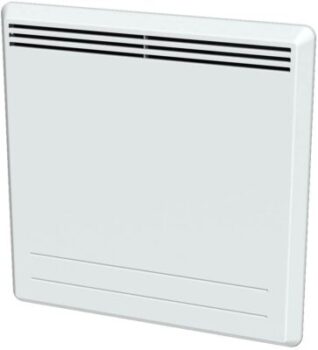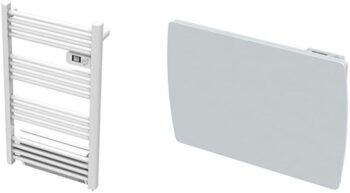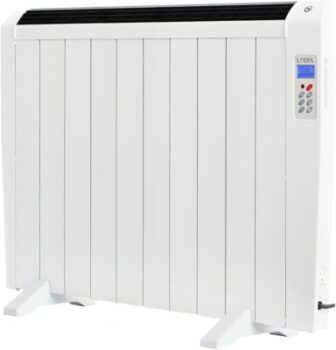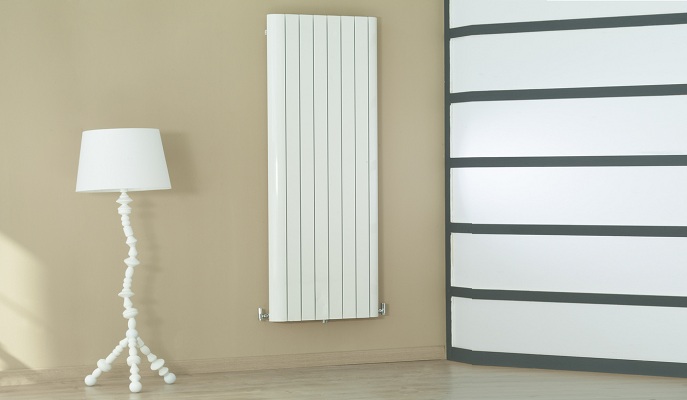To ensure a better thermal comfort in your home in winter, the dry thermal technology is one of the most advanced heating technologies on the market today, with multiple advantages over traditional fluid radiators. This is due in particular to its heating core made of refractory material. But which model to choose? Read our guide to find out.
Here is our commitment, to make sure that we provide the best user experience and content quality:
You can support us by using our links to make your purchases (at no extra cost to you)! This sometimes earns us a commission which allows us to remain independent. More about us
Our selection
"The Carrera 051692 is a visual success, in addition to being quiet, efficient and effective. With its great practicality, its low consumption and its 6…"
"This inertia heater is interesting for several reasons: it's beautiful, light, efficient and inexpensive. Plus, it's straight to the point, no frills, and easy to…"
"The quality of Cayenne and Jarpa products is well known. The combo presented here gathers 2 elements at the same time, that is to say…"
"The Lodel RA10 is versatile. This electric inertia heater can be used as a main heating system or as a backup heater. Its storage surface…"

The Carrera 051692 is a visual success, in addition to being quiet, efficient and effective. With its great practicality, its low consumption and its 6 functions, this inertia heater is really worth the detour.
112 £ on AmazonThe Carrera 051692 is an inertia heater with a cast iron core that is the first choice in most online buying guides. It benefits from an excellent design with a horizontal and flat shape, but above all a frame composed of a mixture of steel and aluminum. The Carrera 051692 develops a heat output of 1,500 W. Of course, its quality/price ratio is unbeatable, but you will also benefit from its eco-friendly and silent side to save energy.
This device is able to heat efficiently and correctly any room in the house, both in a living room and in a bedroom. The first time you use it, the installation and configuration will take no more than 15 minutes. In terms of practicality, the flat and horizontal format allows you to fix it on a wall. The shell is made of steel and aluminum. The LCD screen displays the consumption data and settings. Note that the device has 6 functions: off, frost protection, comfort, comfort-1, comfort-2 and economy.

This inertia heater is interesting for several reasons: it's beautiful, light, efficient and inexpensive. Plus, it's straight to the point, no frills, and easy to use with its LCD screen and easy-to-configure settings.
55,92 £ on AmazonCayenne is a reference brand in terms of inertia heaters. The 49682 is its flagship entry-level model and is currently the best in this category. It has a horizontal format and a ceramic heating core. This model is also distinguished by its lacquered steel frame, which makes it relatively light.
To facilitate the use of its model 48682, Cayenne has equipped it with an electronic thermostat and a digital display. The temperature can be adjusted from 13 to 30°C. The Cayenne 49682 has a number of features, including Off, Frost protection, Comfort, Weekly programming, Consumption, Ecopilot, Ecocitoyen, Prolonged absence, Parental lock and Open window detection.

The quality of Cayenne and Jarpa products is well known. The combo presented here gathers 2 elements at the same time, that is to say a towel warmer and a glass ceramic inertia radiator.
274 £ on AmazonThe towel warmer has a digital display and an electronic thermostat with a fluid-free heating core in an aluminum body. As for its functionalities, it is equipped with various programs, including automatic stop, eco, comfort, frost protection and forced operation.
As for the inertia radiator, it has an automatic or manual time setting, with a temperature adjustment varying from 13 to 30°C and a regulation precision of 0.1°C. It works with a 230V- 50Hz power supply.

The Lodel RA10 is versatile. This electric inertia heater can be used as a main heating system or as a backup heater. Its storage surface is sufficient to ensure a pleasant heat in the house.
178 £ on AmazonThe Lodel RA10 inertia heater has a slim and compact design. It is also a very light electric model mainly due to the use of many quality aluminum components. It is very fast and responsive to heat any room while saving a lot of energy with its low power technology. This model is ideal for heating rooms of 15 to 18 m².
The Lodel RA10 electric radiator has a configurable LCD digital chronothermostat, on which you can choose the operating mode: comfort, economy, anti-freeze and automatic. This model is also very easy to maintain and clean.
Any specific needs?
The best dry inertia radiator in 2021
The best entry-level dry inertia radiator in 2021
The best high-end dry inertia radiator in 2021
Your guide :
Rate this buying guide :By rating this buying guide, you are helping us to reward our best writers. Thank you!
| The best | Inexpensive | Top of the line | Excellent | |

In accordance with our commitment, this buying guide does not contain any sponsored products. |
 9/10 |
 9/10 |
 8/10 |
 9/10 |
| OUR SELECTION |
Carrera 051692
|
Cayenne 49682
|
Cayenne Saturn 500 W and 1000 W blower & Jarpa 49590
|
Lodel RA10
|
|
The Carrera 051692 is a visual success, in addition to being quiet, efficient and effective. With its great practicality, its low consumption and its 6 functions, this inertia heater is really worth the detour.
|
This inertia heater is interesting for several reasons: it's beautiful, light, efficient and inexpensive. Plus, it's straight to the point, no frills, and easy to use with its LCD screen and easy-to-configure settings.
|
The quality of Cayenne and Jarpa products is well known. The combo presented here gathers 2 elements at the same time, that is to say a towel warmer and a glass ceramic inertia radiator.
|
The Lodel RA10 is versatile. This electric inertia heater can be used as a main heating system or as a backup heater. Its storage surface is sufficient to ensure a pleasant heat in the house.
|
|
|
Weight
|
1500 W
|
1000 W
|
500 W / 1000 W
|
1500 W
|
|
Temperature settings
|
18.76 kg
|
8kg
|
8,8 kg
|
8 kg
|
|
Material
|
13°C to 30°C
|
13 °C to 30 °C
|
13°c À 30°C
|
Comfort / economy / antifreeze
|
|
Extra features
|
Melting
|
Ceramic
|
Ceramic
|
Aluminum
|
|
|
off, frost-free, comfort, comfort-1, comfort-2, eco
|
Off, Frost protection, Comfort, Weekly programming, Consumption, Ecopilot, Eco-citizen, Prolonged absence, Parental lock, Open window detection
|
Safetý automatic reset thermal, Customizable weekly programming, Digital display
|
Manual or automatic mode, 24h/ 7 days programming, user configurable, remote control included
|
Help us improve this table:
Report an error, request the addition of a feature to the table, or suggest another product. Thank you for your kindness!
We spend thousands of hours each year studying the major specialized websites, analyzing products of hundreds of brands and reading user feedback to advise you on the best products.
We are a product review company with a single mission: to simplify your buying decisions. Our research and testing helps millions of people every year find the best products for their personal needs and budget.
To support us you can: use our links to make your purchases (which often earns us a small commission), share our articles on social networks, or recommend our site on your blog. Thanks in advance for your support!

This criterion is to be defined according to the surface of the room in which it will be installed:
It should be determined according to your personal preferences and the final touch you want to bring to the room. You have the choice between:
You should never buy a space heater without a warranty. If something goes wrong with your heater, a warranty promises repair or replacement. The length of warranty offered with each heater is a good measure of its quality. If there is a warranty, ask the manufacturer for a list of parts covered by that warranty.
You have a lot of features to choose from, namely:
When you consider buying an electric heater, you should make sure that the product is validated by the appropriate safety accreditation programs. At the very least, your electric heater should carry the CE mark, which is the manufacturer's declaration that the device meets the minimum safety standards required by European legislation.
Please read the safety instructions carefully before using a dry heat radiator.
CAUTION - Parts of a dry heat unit can become very hot and cause burns.
The dry inertia radiator is an even and gentle heating system. This is due to the fact that the temperature variations are less abrupt to provide the inhabitants of a house with a better thermal comfort.
The operating principle of the dry inertia radiator is based on the use of a solid heating body made of refractory material, ie resistant to heat. This material can be stone, cast iron, etc..
The electric resistance is placed in the heart of this refractory material to raise its temperature. The high level of thermal inertia of the materials that make up this type of radiator allows them to store heat efficiently when the appliance is in use.
A dry inertia radiator is more durable than a fluid inertia model and is best suited for high-traffic living areas. It is more expensive to purchase, but is a successful investment over the long term.
This inertia heater uses heat transfer fluids to produce heat. It is operated by glycol, vegetable oil or mineral oil.
It is much less expensive than a dry inertia model, but heats just as quickly as the dry inertia model. The difference is that the dry inertia model is more robust and durable than a dry inertia heater.
The fluid inertia radiator offers the same feeling as with a central heating system. Contrary to the dry inertia radiator, it allows a faster rise in temperature while being voracious in electricity.
In terms of thermal performance, the two devices are equal. However, the choice between the two will depend on the surface to be heated. A small space of about fifteen square meters will need a heating at 20°C, which is the equivalent of a power of 1,000 W. The larger the space to be heated, the greater the power required of the heater.

For instant heat and gentle warmth
Because ceramic plates absorb heat, they can reach the desired temperature quickly, often faster than other types of radiators. Dry heaters are also known to generate gentle, non-smothering heat compared to fan heaters, thanks to the solid plates that heat up gradually before heating the room.
To save electricity
Once the heating plate reaches the set temperature, the electric current is turned off and the heat stored in the ceramic material continues to heat your room. This means that less energy is needed to produce more heat, so it is economical to operate and dry inertia heaters are environmentally friendly.
To be environmentally friendly
Compared to stoves using wood or fossil fuels such as gas, the efficiency of a ceramic radiator varies between 85 and 90%. These efficiencies are very comparable to other types of radiators, but they are also environmentally friendly.
For its compactness
Because they are so efficient, they produce a lot of heat despite their small size. This is an asset when your space is limited. The dry inertia heater is also the best alternative for heating larger rooms where you need a more powerful and discreet heat source.
To reduce the risk of fire from heating systems
Dry heaters are very safe because ceramic plates completely surround the heating elements, so there is no possibility of sparks that could cause a fire. They also have built-in safety features that facilitate the convection heating process and prevent overheating with a thermostat.
For less pollution
One of the great advantages of electric heaters over gas heating is that there are no harmful fumes emitted, such as the gas itself or the carbon monoxide that a faulty stove can emit when burned incorrectly.
In our opinion, the best brands of dry inertia heaters in 2022 are :
With more than 20 years of experience, Cayenne has positioned itself as a reference in the world of cooling and heating with its high-quality, reliable and high-performance appliances. The brand is a hit with consumers thanks to its easy-to-install, powerful, economical, CE and NF-certified, eco-friendly and unbeatable value-for-money radiators.
Trotec is a German company with more than 20 years of experience in dehumidification, heating, air conditioning and ventilation for industry, craftsmen and individuals. Trotec offers a wide range of products internationally including electric radiators, convectors, fan heaters, unit heaters which are so coveted in this field because of their power, high performance and compactness especially for heating spacious rooms.
Carrera is a reference in radiator. Its models have the reputation of having a decent quality-price ratio, high performance as well as a beautiful design. CE and NF certified, Carrera's radiators guarantee safety and reliability.
A Spanish company with more than 19 years of experience in electric radiators. It has a solid knowledge in thermal product allowing them to constantly innovate.
It is a great company that manufactures all kinds of equipment for the home from water heater to radiator. 50 years of expertise on the counter, it is a brand with a guarantee of quality.
The diagram below will help you to get an idea of the typical prices for each price range (entry-level, mid-range and high-end).
However, more expensive does not necessarily mean better.
We therefore advise you to always consult our ranking before deciding, rather than blindly relying on price ranges.
Surface temperature limiter
To avoid burns, you will need to fit your electric heater with a thermal safety limiter that will cut off power to the heater if the surface temperature exceeds a set limit. This prevents your radiator from overheating and is especially important in homes with young children or vulnerable adults.
Installation
Most electric radiators are suitable for DIY installation. It's an easy task that requires minimal DIY skills. Radiators simply screw into the wall and plug into the nearest outlet, like a TV.
If you want to mount your radiator on a stand, make sure the radiator is available with a set of legs or wheels.
If you don't want to install the radiators yourself, you can pay an electrician to do the work. Electricians will mount the radiator for you and can also wire the radiator into the wall. This is recommended if you want a discreet installation without loose wires or plugs.
Recycling
Any dry inertia radiator should not be thrown away with the regular garbage; it should be taken to a local electrical appliance collection and recycling center.
Best location for a dry inertia heater
The best place for a radiator is in the coolest part of the room. Under a window, for example. However, in more modern double-glazed homes, there may not be a cold area, so you can place radiators where they won't affect wall use. A general rule of thumb is to have a radiator about every 4 m in a room.
Locations to avoid for a heater
Wherever you choose to place it, try not to place your radiator behind large pieces of furniture, such as the sofa or cabinets. This will limit the flow of warm air into the room.
To obtain the power of an electric radiator, you just have to multiply the surface by 100 W if your house is poorly or moderately insulated. On the other hand, if it is very well insulated, multiply the surface area by 60 W and by 125 W on average for the bathroom.
A dry inertia radiatorhas a ceramic or cast iron core. The fluid inertia radiator, on the other hand, offers a faster rise in temperature in particular, thanks to its metal heating body and the fluid that is inside. The latter spreads the heat more quickly throughout the body of the radiator.
Windows are traditionally the most insulated surfaces in a building envelope. In the 20th century, to combat this cold feeling and keep the room comfortably warm, radiators were always placed under a window. The rising heat from the radiator forms a kind of warm air curtain that protects you from the cold air.
It is not advisable to leave electric radiators on at night. Electric heaters can be a fire hazard, especially when placed near curtains, comforters, rugs and other materials often found in bedrooms.
Every month we help more than 1 000 000 people buy better and smarter.
Copyright © 2022 - Made with ♥ by buyingbetter.co.uk
Your reviews and buying guides 0% advertising, 100% independent!